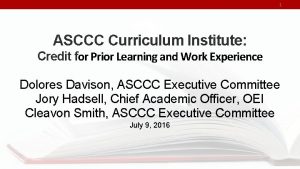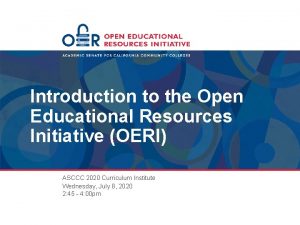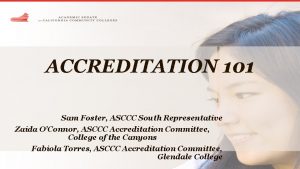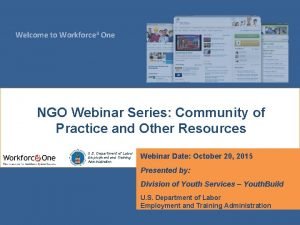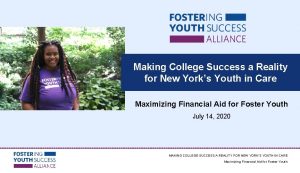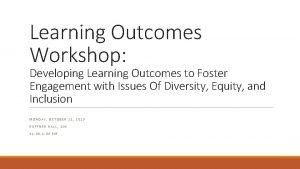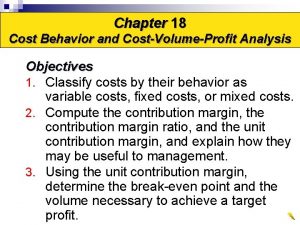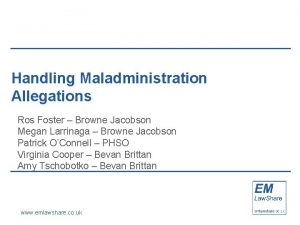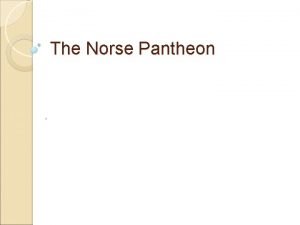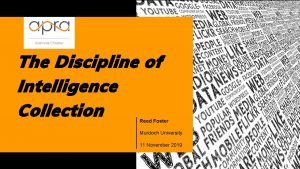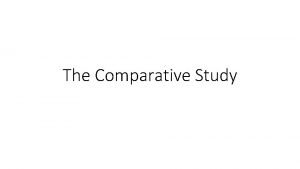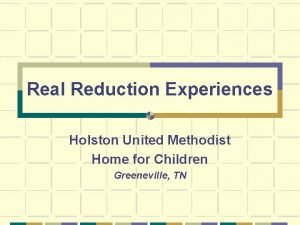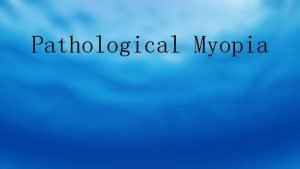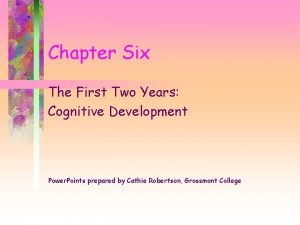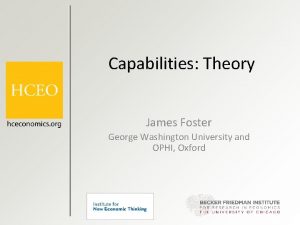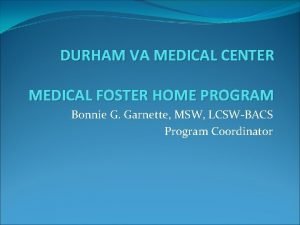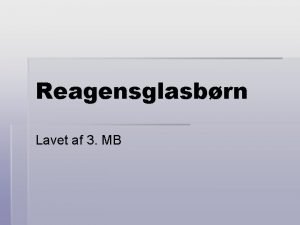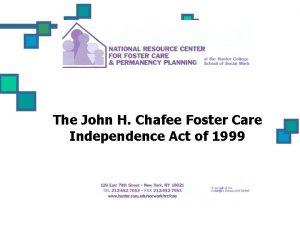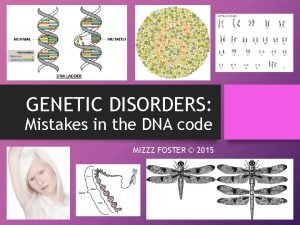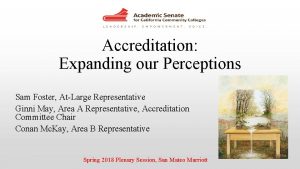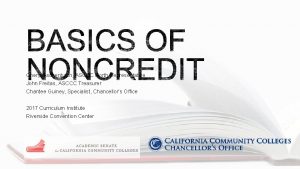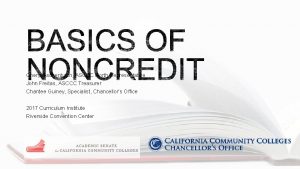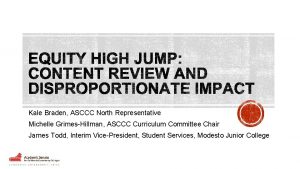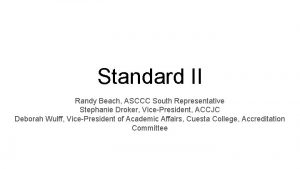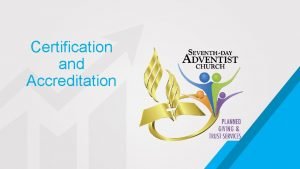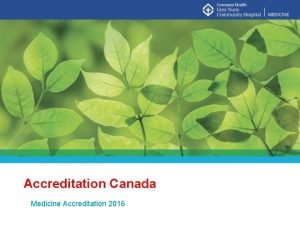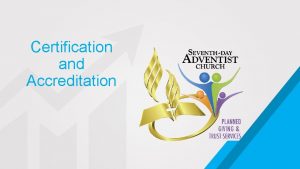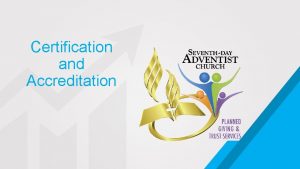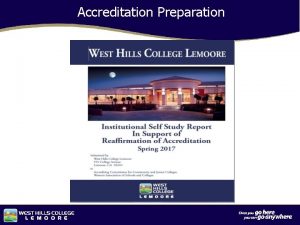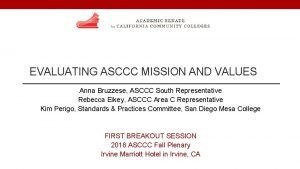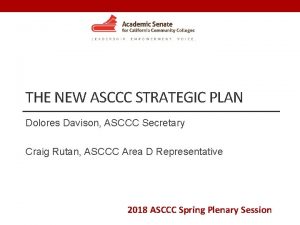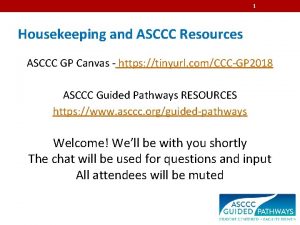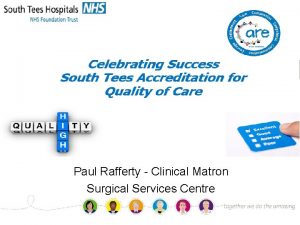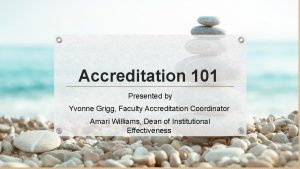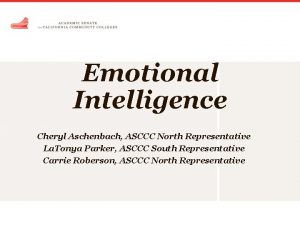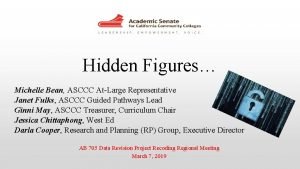ACCREDITATION 101 Sam Foster ASCCC South Representative Zaida









































- Slides: 41

ACCREDITATION 101 Sam Foster, ASCCC South Representative Zaida O’Connor, ASCCC Accreditation Committee, College of the Canyons Fabiola Torres, ASCCC Accreditation Committee, Glendale College

What is your view of accreditation? 2017 ASCCC Accreditation Institute, Napa, CA 2

2017 ASCCC Accreditation Institute, Napa, CA 3

Temperature Check • What brings you to this breakout? • What is your role on your local campus? • What is your prior experience with accreditation? 2017 ASCCC Accreditation Institute, Napa, CA 4

Objectives • This presentation is designed to provide an overview of the ACCJC Accreditation Standards and a basic understanding of the accreditation process • We also will discuss how distance education is integrated through all four standards 2017 ASCCC Accreditation Institute, Napa, CA 5

Which of the following is true of accreditation ? A. It compares colleges to best practices in education. B. It punishes colleges based upon audits. C. It grades and ranks colleges based on standards. D. It is a means of monitoring colleges. E. It guarantees the quality of education to the federal government and the public. 2017 ASCCC Accreditation Institute, Napa, CA 6

Who participates in accreditation processes? A. Faculty B. Administration C. Classified Staff D. Students E. All of the above 2017 ASCCC Accreditation Institute, Napa, CA 7

What is accreditation? • Accreditation is the process for evaluating and assuring the quality of education used by the American higher education community. • Accreditation is a peer driven process where a team of fellow educators come to your campus to evaluate the performance of your college based on established standards. 2017 ASCCC Accreditation Institute, Napa, CA 8

Accreditation can be considered quality assurance. 2017 ASCCC Accreditation Institute, Napa, CA 9

Role of Local Academic Senates in Accreditation • Providing and ensuring faculty leadership and involvement in accreditation • Faculty involvement in accreditation is an academic and professional matter • From Title 5 § 53200(c)(7): Faculty roles and involvement in accreditation processes, including self- study and annual reports 2017 ASCCC Accreditation Institute, Napa, CA 10

What roles do faculty play in the accreditation process? 2017 ASCCC Accreditation Institute, Napa, CA 11

What roles do faculty play in the accreditation process? A. Representation on committees B. Writing the Institutional Self Evaluation C. Serving as the Accreditation Liaison Officer (ALO) D. Validating the accuracy of the report to the student perspective E. Meeting with Accreditation team visitors F. All of the above 2017 ASCCC Accreditation Institute, Napa, CA 12

Another Definition Accreditation is a voluntary system of self regulation developed to evaluate overall educational quality and institutional effectiveness and assures… • the public that accredited colleges meet the standards • education earned is of value to the student • employers, trade or profession-related licensing agencies, and other colleges and universities can accept a student’s credentials as legitimate 2017 ASCCC Accreditation Institute, Napa, CA 13

Accrediting Commission • The California community colleges are accredited by the Accrediting Commission for Community and Junior Colleges (ACCJC) • Each of our colleges is a member of ACCJC and has a role in electing the members of the commission. • The commissioners are administrators, faculty, and members of the public, not only from our system but from Hawai’i and the Pacific as well. 2017 ASCCC Accreditation Institute, Napa, CA 14

The Role of the ACCJC assures the educational community, the general public, and other organizations and agencies that an institution… • has clearly defined objectives appropriate to higher education • has established conditions under which their achievement can reasonably be expected • appears in fact to be accomplishing them substantially • is so organized, staffed, and supported that it can be expected to continue to do so; and demonstrates that it meets Accreditation Standards 2017 ASCCC Accreditation Institute, Napa, CA 15

Standard I: Mission, Academic Quality and Institutional Effectiveness, and Integrity Standard Description I. A Mission I. B. 1 -4 Assuring Academic Quality and Institutional Effectiveness: Academic Quality I. B. 5 -9 Assuring Academic Quality and Institutional Effectiveness: Institutional Effectiveness I. C Institutional Integrity 2017 ASCCC Accreditation Institute, Napa, CA 16

Standard II: Student Learning Programs and Support Services Standard Description II. A Instructional Programs II. B Library and Learning Support Services II. C Student Support Services 2017 ASCCC Accreditation Institute, Napa, CA 17

Standard III: Resources Standard III. A III. B III. C III. D. 1 -3 III. D. 4 -10 III. D. 11 -15 III. D. 16 Description Human Resources Physical Resources Technology Resources Fiscal Resources: Planning Fiscal Resources: Fiscal Responsibility and Stability Fiscal Resources: Liabilities Fiscal Resources: Contractual Agreements 2017 ASCCC Accreditation Institute, Napa, CA 18

Standard IV: Leadership and Governance 2017 ASCCC Accreditation Institute, Napa, CA 19

Standard IV: Leadership and Governance Standard Description IV. A Decision-Making Roles and Processes IV. B Chief Executive Officer (College President) IV. C Governing Board (Board of Trustees) IV. D Multi-College Districts or Systems 2017 ASCCC Accreditation Institute, Napa, CA 20

Accreditation Focuses On • Institutional commitments • Evaluation planning and improvement • Student learning outcomes • Organization • Dialogue • Institutional integrity • Your college must provide clear evidence for anything that is claimed. Claims without evidence won’t work! 2017 ASCCC Accreditation Institute, Napa, CA 21

Things That Need to be Documented • Program Review • Planning • Resource Allocation • Decision-Making • Assessment • Evaluation of the processes • Improvement 2017 ASCCC Accreditation Institute, Napa, CA 22

What about Distance Education (DE) and Correspondence Education(CE)? • Distance Education (and CE) courses and programs must be addressed in the same way as face-to-face offerings • DE/CE must be addressed in all of the accreditation standards 2017 ASCCC Accreditation Institute, Napa, CA 23

Integrating Distance Education into the Standards Standard I: Institution • Clear mission statement with language that aligns with the college mission statement • Present in the Org Chart • Clear faculty contract language on load, faculty development, and scheduling. 2017 ASCCC Accreditation Institute, Napa, CA 24

Integrating Distance Education into the Standards Standard I: Institution (Cont’d) § Certification and faculty development § Authentication policies & procedures (in class and institutionally) § C&I & DE relationship § DSPS & Academic Integrity 2017 ASCCC Accreditation Institute, Napa, CA 25

Integrating Distance Education into the Standards Standard II: Learning • Double check DE programs are still aligned with the Substantive Change Report • Triple Check faculty on online programs are designing courses that are aligned with the your local Regular and Effective Contact Policies 2017 ASCCC Accreditation Institute, Napa, CA 26

Integrating Distance Education into the Standards Standard II: Learning (Cont’d) • Demonstrate the practice and intent to further grow student access and services for the DE student • Describe how is DATA USED to improve growth and support for programs? • Make sure there is a relationship between DE course design & DSPS 2017 ASCCC Accreditation Institute, Napa, CA 27

Integrating Distance Education into the Standards Standard III: Resources ØWho gets to teach DE? Make it clear in the HR section. ØBoast about your Faculty Learning/Development opportunities (physical space or online) ØClarify any FLEX language that is DIFFERENT for DE faculty. Ø Include academic integrity resources (licenses and training) ØDescribe DSPS Services for students **Make sure folks are using the campus selected LMS! 2017 ASCCC Accreditation Institute, Napa, CA 28

Integrating Distance Education into the Standards Standard IV: Leadership • Make sure the ORG Chart includes DE • Apply DE language on the following: • Senate participation/contribution with DE • DE Committee Minutes and Agendas • DE Coordinator Job Description 2017 ASCCC Accreditation Institute, Napa, CA 29

Integrating Distance Education into the Standards Standard IV: Leadership (Cont’d) • C&I Jurisdiction to Course Approval and/or record keeping • IT and Instruction - How is IT working with instruction with DE? • Faculty Development focused on DE • DSPS Contribution to DE 2017 ASCCC Accreditation Institute, Napa, CA 30

Preparing for Accreditation Locally • Traditionally, colleges bring together a steering committee 18 – 24 months prior to the submission of a self evaluation to prepare the report. • As the documentation requirements have increased, this method has become very difficult to sustain. • Your may choose to consider incorporating evidence collection, documentation, and even some writing into the work of your existing structures. The accreditation committee then won’t be starting from scratch! 2017 ASCCC Accreditation Institute, Napa, CA 31

Getting People Involved 2017 ASCCC Accreditation Institute, Napa, CA 32

Getting People Involved • How do you recruit faculty? • How do you structure your accreditation committee? • Will there be an internal or external editor for the self evaluation? • What do you do when people miss deadlines? • Is there reassign time available? • How can you leverage existing processes and structures? 2017 ASCCC Accreditation Institute, Napa, CA 33

The Accreditation Liaison Officer vs the Faculty Accreditation Chair 2017 ASCCC Accreditation Institute, Napa, CA 34

The Accreditation Liaison Officer vs the Faculty Accreditation Chair • ALO is the conduit to the ACCJC and is responsible for informing administration and campus about accreditation efforts • Faculty chair is responsible for faculty participation, involvement, and role within the accreditation efforts • The relationship between the ALO and the faculty chair is essential; both should attend training sessions, participate in ACCJC sponsored events, and the like. 2017 ASCCC Accreditation Institute, Napa, CA 35

Summary What is next? 2017 ASCCC Accreditation Institute, Napa, CA 36

2017 ASCCC Accreditation Institute, Napa, CA 37

Available Resources from ACCJC • Accreditation Reference Handbook • Checklist for Evaluating Compliance with Federal Regulations and Related Commission Policies • Eligibility, Candidacy, and Initial Accreditation Manual • Guide to Evaluating & Improving Institutions • Guide to Evaluating Distance Education and Correspondence Education 2017 ASCCC Accreditation Institute, Napa, CA 38

Available Resources from ASCCC • Effective Practices in Accreditation • ASCCC Accreditation Committee web page 2017 ASCCC Accreditation Institute, Napa, CA 39

Questions? 2017 ASCCC Accreditation Institute, Napa, CA 40

Contact us…. • Sam Foster (SFoster@fullcoll. edu) • Zaida O’Connor (zaida_ocon@yahoo. com ) • Fabiola Torres (ftorres@glendale. edu) 2017 ASCCC Accreditation Institute, Napa, CA 41
 Asccc curriculum institute
Asccc curriculum institute Asccc oeri
Asccc oeri Asccc leadership institute
Asccc leadership institute Zaida padilla
Zaida padilla Zaida padilla santana
Zaida padilla santana Old south vs new south streetcar named desire
Old south vs new south streetcar named desire Andrea foster mack
Andrea foster mack Containment apush def
Containment apush def Foster youth college success initiative
Foster youth college success initiative Foster and freeman vsc 80
Foster and freeman vsc 80 Dr andrew foster deaf
Dr andrew foster deaf Tiburcio noli me tangere
Tiburcio noli me tangere How foster children
How foster children Cost volume
Cost volume Foster lifelong engagement
Foster lifelong engagement Megan larrinaga
Megan larrinaga Nancy foster aha
Nancy foster aha Foster brother to odin
Foster brother to odin Elizabeth foster fsu
Elizabeth foster fsu Pros and cons of humint
Pros and cons of humint A poem to my foster dog
A poem to my foster dog Hero heroine villain comparative study
Hero heroine villain comparative study Holston homes foster care
Holston homes foster care New foundations home for child anderson sc
New foundations home for child anderson sc Rebekah foster
Rebekah foster Foster and maintain business relationships
Foster and maintain business relationships Portal arg
Portal arg Forster fuchs spots
Forster fuchs spots Social impulses foster infant language
Social impulses foster infant language James foster gwu
James foster gwu Va medical foster home
Va medical foster home Nancy foster aha
Nancy foster aha Saliromani
Saliromani Hannah foster
Hannah foster Prayer of relinquishment foster
Prayer of relinquishment foster Mizzz foster
Mizzz foster John h chafee foster care independence program
John h chafee foster care independence program Prometheus foster city
Prometheus foster city Manuel roxas contribution in the philippines
Manuel roxas contribution in the philippines Chromosomal mutation
Chromosomal mutation Horse whisperer poem
Horse whisperer poem Foster miller probe
Foster miller probe
